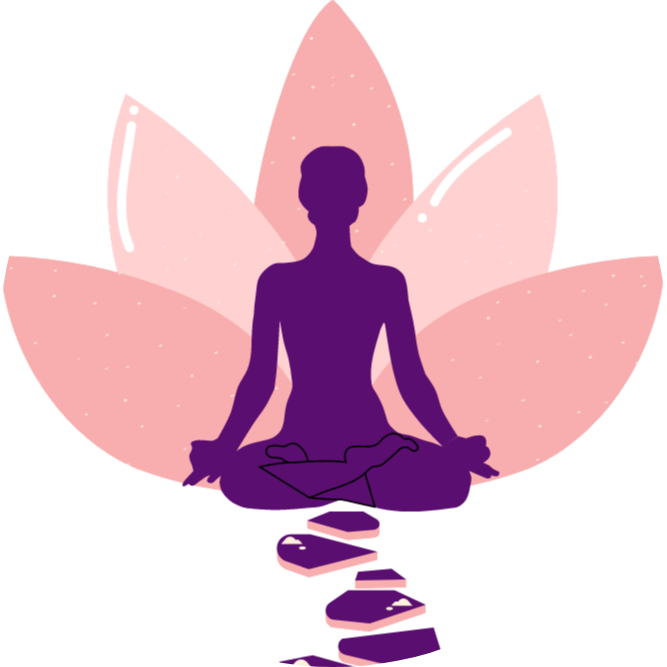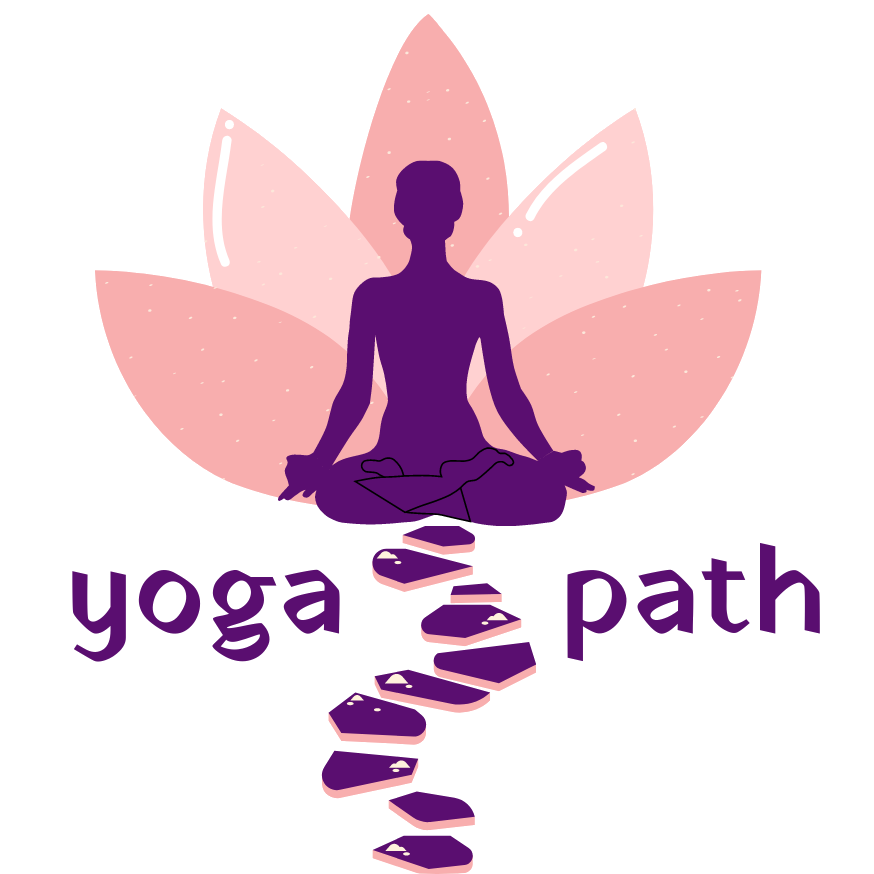Sleep well with Yoga
ASANAS FOR INSOMNIA
Tossing and turning in search of sleep?
Try yoga.
As we plunge into our day, with our thoughts scattered in different directions, the Rajas Guna is at its peak and driving us to achieve. But at night its the Tamas Guna (though looked down by many) that is welcomed, where we must slow down and retire our activities of both mind and body before we hit the pillow.
But most often than not we are unable to switch off. This is where yoga weaves its magic.
Yoga if done daily, regularly for a few minutes helps to relax both mind and body, slows the heart, and deepens the breath. This naturally welcomes sleep.
Hastapadasana
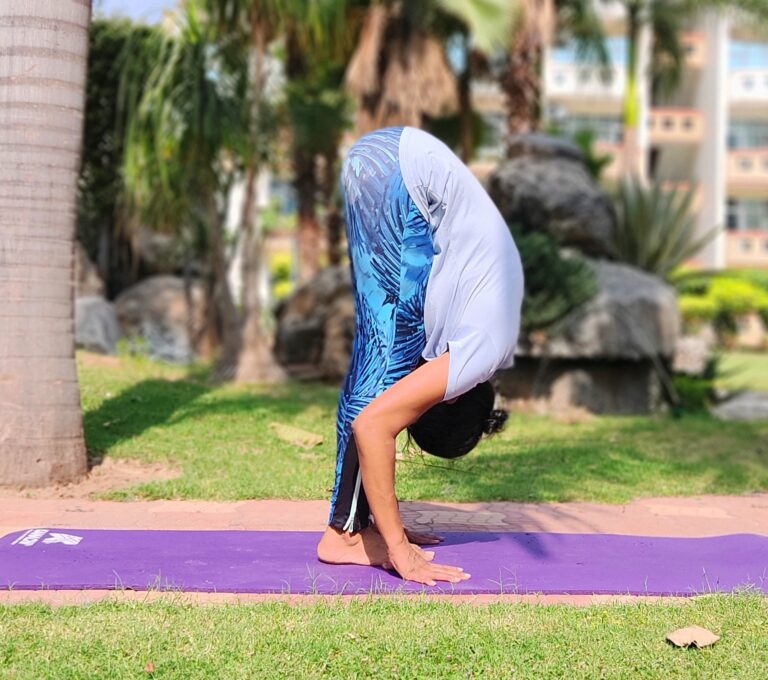
Standing Position – Forward Bend
Hastapadasana meaning Hand to Feet Pose
This asana flows with humility and acceptance of the self along with surrender to the universe. It represents a cycle of energy generated within the body and offered to the universe.
Stand with your feet together and hands at the side.
While inhaling, raise both your hands from the front above your head.
While exhaling, bring the your hands down to touch your toes or grasp your ankles keeping your knees straight.
Remember to keep your ears and hands together as a unit as you bend down or rise up. Keeping your knees straight, try to touch your forehead to the knees. Stay in the position for 6 seconds breathing normally – extend to 2 minutes.
While inhaling, raise your hands up above your head and exhaling bring your arms down to the sides.
Contraindications:
Hypertension, Cardiac ailments, Pregnancy, Peptic ulcers, Hernia, Back or Spinal Injuries, Cervical spondylitis, Slipped disc and serious Eye disorders such as glaucoma and myopia.
Benefits:
Results in extreme stretching of back and leg muscles
Brings flexibility to your spine
Abdominal compression provides good circulation and massage to abdomen and pelvic organs
Tones the abdominal wall and reduces unnecessary fat deposits in the abdominal area
Induces clavicular breathing and aids proper ventilation of the uppermost part of the lungs
Stimulates the nervous system and endocrine system
Improves blood circulation
Aids sleep
Viparita Karni
Supine Position – Legs Raised
The pose described here is a passive, supported variation of the Shoulder Stand, like Viparita Karani. You’ll need to rest your legs vertically on a wall or other upright support.
Sit sideways with your right side against the wall, lie down lowering your back and head on the floor. Exhale and slowly slide your legs up onto the wall sideways while your back, shoulders and head are down on the floor.
Lift and release the base of your skull away from the back of your neck and soften your throat. Don’t push your chin against your sternum.
Open your shoulder blades away from the spine and release your hands and arms out to your sides, palms up.
Keep your legs straight. Feel the weight of your legs and belly deeply into your torso, toward the back of the pelvis. Soften your eyes and turn them down to look into your heart.
Stay in this pose for 1 minute – you can increase to 15 minutes.
Then bend your legs, and turn to the side. Stay on your side fora few breaths, and come up to sitting with an exhalation.
Contraindications:
Glaucoma and serious eye problems, Back injury or neck injury and during Menstruation
Benefits:
Reduces grey hair and wrinkles
Decreases Anxiety, mild Depression, Migraine, Headache and calms the mind
Helps with Arthritis
Relieves Digestive problems, Piles, Fissures and Urinary disorders
Helps High and low blood pressure
Reduces Varicose veins
Relaxes Menstrual cramps, Premenstrual syndrome and Menopause
Heals Respiratory ailments
Relaxes cramped legs and feet
Benefits blood circulation at abdomen and lower back and organs in this area
Reduces Insomnia
Uttana Shishosana
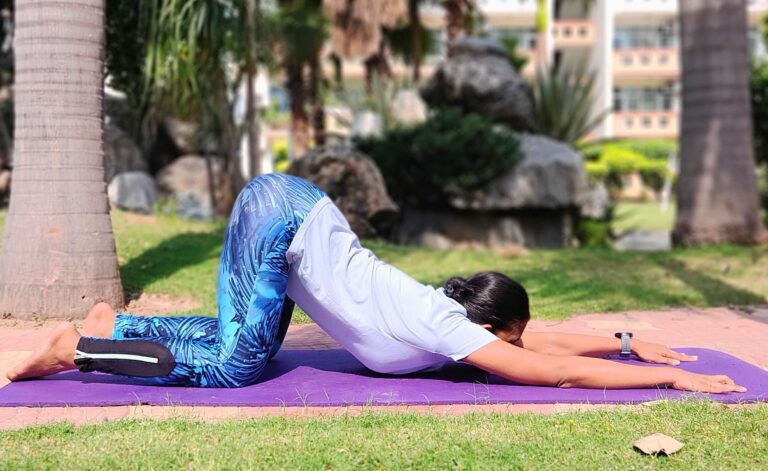
Prone Position – Forward Bend
Uttana Shishosana, also known as Extended Puppy Pose, is a combination of two different asanas, the Child Pose and the Downward Facing Dog Pose.
This pose relieves stress by deeply stretching the spine. It increases self-confidence and a feeling of self-love. This asana releases any tension knotted up in your back and shoulders. If you have a desk job or you are feeling fatigued, do practice this asana.
Start from a tabletop position i.e. on all four limbs with knees stacked under hips and palms right under shoulders. Press your feet firmly on the mat and keep your toes flat out with soles facing the ceiling.
While exhaling, keep your hands in front of you. Now allow your chest to slowly lower down towards the floor while slowly placing your forehead on the mat. Spread your palms firmly on the floor. Stretch your arms ahead of you on the floor so that your shoulders get broadened. The hips remain upwards and behind.
Hold the stretch for around 5-7 breaths while breathing deeply. Release by coming back into the tabletop position and then sitting in Vajrasana
Contraindications:
Knee injury, Back injury, Hip injury, Frozen shoulders and later stages of Pregnancy.
Benefits:
Stretches your spine and shoulders Helps in strengthening the body Makes the spine flexible and strong Strengthens hips, upper back and arms Deeply calms the mind with regular practice Improves posture Activates the Heart Chakra and Throat Chakra Increases self confidence Make you cheerful and optimistic Improves breathing capacity of lungs Releases stress and tension Induces deep sleep and cures insomniaSupta Vakrasana – Lying Down
Supine Position – Spinal torsion
Lie down on your back on the mat, legs stretched forward and hands by the sides Stretch the arms out, perpendicular to the body in a T.
Now, fold the legs at the knees and draw the feet in. Keep the feet and knees together, perpendicular to the floor. Inhale normally. Exhaling, in gently let the legs fall together to the left, to allow the knees to rest on the floor with both knees one above the other. Simultaneously, turn the neck to the right, to gaze at the right thumb.
Hold this pose for few seconds, with the breath suspended. Move the legs raising the knees back up while inhaling. Without a pause, exhaling, in 3 seconds, repeat the above steps to the right, to complete 1 round.
Contraindications:
Severe back pain, Abdominal inflammations, Ulcers and Sciatica.
Benefits:
Exercises and relaxes the spinal muscles
Gently exercises the abdominal and back muscles
Helps alleviate chronic back and shoulder pain
Lower back – strengthens muscles, relieves stiffness and alleviates pain
Improves digestion and combats constipation
Trims the waist line and reduces abdominal fat
Marjari Asana & Bitila Asana
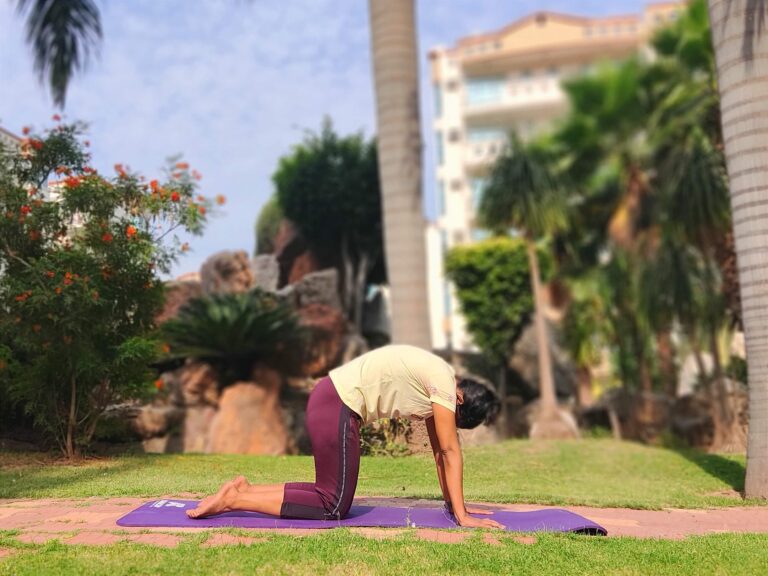
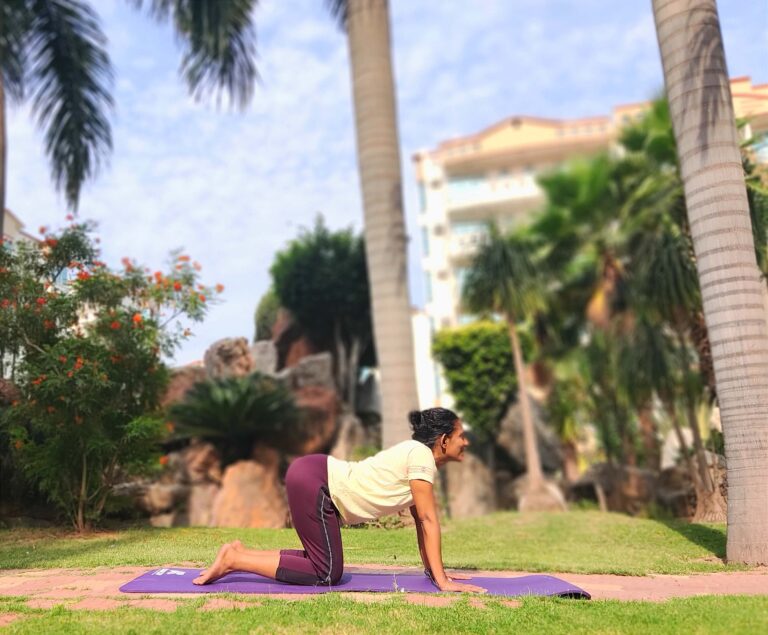
Forward Bend & Backward Bend
Marjari meaning Cat, Bitila meaning Cow
In this asana, sit in Vajrasana then come on all fours or table top with with knees and palms on the floor. The palms are at shoulder distance on the floor also the knees and feet are at hip distance apart. The palms are directly under the shoulder with arm perpendicular to the floor and the knees are under the hips. Look straight ahead. As you inhale, raise your chin, tilt your head and chest back pushing the palms firmly into ground push your navel downwards and raise your tailbone. Hold this cat pose and take long, deep breaths.
Follow this by Bitilasana, a counter pose: As you exhale, drop your chin to your chest and arch your back up as much as you can; pull in the pelvic and chest to form a curve in the spine. Hold this pose for a few seconds.
Contraindications:
Weak wrists injury or surgery to wrists
Shoulder injury back injury
Weak or injured knee – use padding under knees
Benefits:
Brings flexibility to the spine
Stretches the back and relaxes it
Stretches the scapula out and in and increases mobility
Strengthens lower back
Strengthens wrists and shoulders
Massages the digestive organs and improves digestion
Tones the abdomen
Relaxes the mind
Relieves menstrual pain
Improves focus
Improves blood circulation
Shavasana
Supine Position – Relaxation Pose
Shava meaning Corpse.
This pose gets its name from the reclined posture of a dead body. It is a position of rest, relaxation, and rejuvenation is usually practiced towards the end of a yoga session.
Lie flat on your back and close your eyes. Keep your legs at a comfortable distance apart and relaxed and toes facing to the sides. Place your arms a little spread apart from your body. Leave your palms open, facing upward.
Taking your attention to different body parts one by one, slowly relax your entire body.
Begin with bringing your awareness to the right foot, move on to the right knee (in the same way you complete one leg, and move your focus to the other leg), and so on, and slowly move upwards to your head, relaxing each part of the body.
Keep breathing slowly, gently, deeply and allow your breath to relax you deeper. The incoming breath heals the body while the outgoing breath relaxes. Make sure you don’t fall asleep!
After some time, about 5-20minutes when you feel fully relaxed, keeping your eyes closed, slowly roll onto your right side. Lie in that position for a few seconds or so. Then, with your eyes still closed, sit up into cross legged pose (Sukhasana) taking the support of your right hand. Take a few deep breaths in and out.
When you feel completely in touch with your surroundings, slowly and gently open your eyes.
Benefits:
Deep, meditative state of rest, which helps in the repair of tissues and cells
Releases stress
Helps rejuvenation
Reduces blood pressure, anxiety, and insomnia.
This is an excellent way to ground the body and reduce the Vata dosha (imbalance of the air element) in the body.
